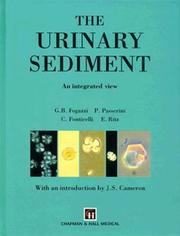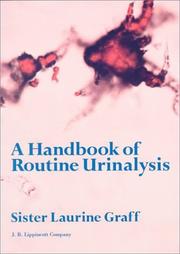| Listing 1 - 10 of 38 | << page >> |
Sort by
|

ISBN: 0412593009 Year: 1994 Publisher: London Chapman and Hall
Abstract | Keywords | Export | Availability | Bookmark
 Loading...
Loading...Choose an application
- Reference Manager
- EndNote
- RefWorks (Direct export to RefWorks)
Urinalysis. --- Urinalyses --- Urinalysis
Book
Abstract | Keywords | Export | Availability | Bookmark
 Loading...
Loading...Choose an application
- Reference Manager
- EndNote
- RefWorks (Direct export to RefWorks)
Microscopy --- Urinalysis
Book
Year: 1975 Publisher: Leuven Wouters
Abstract | Keywords | Export | Availability | Bookmark
 Loading...
Loading...Choose an application
- Reference Manager
- EndNote
- RefWorks (Direct export to RefWorks)
Book
Abstract | Keywords | Export | Availability | Bookmark
 Loading...
Loading...Choose an application
- Reference Manager
- EndNote
- RefWorks (Direct export to RefWorks)
Book
Abstract | Keywords | Export | Availability | Bookmark
 Loading...
Loading...Choose an application
- Reference Manager
- EndNote
- RefWorks (Direct export to RefWorks)
Book
Abstract | Keywords | Export | Availability | Bookmark
 Loading...
Loading...Choose an application
- Reference Manager
- EndNote
- RefWorks (Direct export to RefWorks)
Book
Year: 2006 Publisher: Bruxelles: UCL,
Abstract | Keywords | Export | Availability | Bookmark
 Loading...
Loading...Choose an application
- Reference Manager
- EndNote
- RefWorks (Direct export to RefWorks)
The use of hallucinogens is in emergence for a few years. It is according that the laboratory of Toxicology of the Institute of Criminalistic and Criminality decided to develop this method of detection.
The different psychotropic substances and metabolites which integrated the method are 17: cathinone, bufotenine, psilocine, scopolamine, mescaline, ketamine, norketamine, methylphénidate, harmaline, harmine, lobeline, ibogaine, chlorpheniramine, acide ritalinique, kavaïn, 2-oxo-3hydroxy-LSD and LSD.
The choice of the biological type of matrix was directed towards the urine because this one has the advantages of detecting strong concentrations of drugs and allows the detection of a few hours to a few days.
In order to analyze these substances, from which the physicochemical properties are relatively different, the use of the chromatography coupled to mass spectrometer out of tandem (LC-MS/MS) proved like the best choice.
The preparation of the samples was carried out by and extraction in solid phase (SPE) by means of cartridges “mixed mode cation exchange” (MCX) which enabled us to obtain an excellent output whose values oscillate between 76.3% and 105.5%. The reduction of the signal-to-noise ratio, the use of two transitions for each substance (qualifier and quantifier) and the fact of using “deutérés” compounds provided us in correlation with the parameters of times of retention a very high specificity and sensibility.
One of the principal goals of our study was to obtain an extremely low quantification for the LSD. The value obtained for the LOQ of the LSD is 0.00625 ng.
Some low external controls of LSD were added for each analysis; their standard deviations are lower than 10%. The solutions controls containing the LSD are used in routine in the laboratory of Toxicology. At the end of the study, applications on real cases showed that the psilocine, the ketamine and the norketamine can be identified and quantified easily with this method of detection.
Moreover, analysis on plants like the datura (scopolamine) and the peyotl (mescaline) made it possible to identify their hallucinogens. This method could consequently become qualitative for the detection of these psychotropic in the materials of seizure.
In conclusion, the method of detection of hallucinogens offers beautiful prospects for the future because the hallucinogens will be probably drugs of tomorrow. L'utilisation de composés hallucinogènes est en pleine émergence depuis quelques années. C'est dans cette optique que le laboratoire de Toxicologie de l'Institut de Criminalistique et de Criminalité a décidé de développer cette méthode de détection.
Les différentes substances psychotropes et métabolites qui ont intégrées la méthode sont au nombre de 17 : cathinone, bufoténine, psilocine, scopolamine, mescaline, kétamine, norkétamine, méthylphénidate, harmaline, harmine, lobéline, ibogaine, chlorphéniramine, acide ritalinique, kavaïn, 2-oxo-3hydroxy-LSD et LSD.
Le choix du type de matrice biologique s'est orienté vers l'urine car celle-ci présente les avantages de détecter de fortes concentrations de drogues et de réaliser la détection de quelques heures à quelques jours.
Afin d'analyser ces substances, dont les propriétés physico-chimiques sont relativement différentes, l'utilisation de la chromatographie couplée à spectromètre de masse en tandem (LC-MS/MS) s'est avéré comme le meilleur choix.
La préparation des échantillons a été réalisée par une extraction en phase solide (SPE) au moyen de cartouches « mixed mode cation exchange » (MCX) qui nous ont permis d'obtenir un excellent rendement dont les valeurs oscillent entre 76.3% et 105.5%.
La diminution du rapport signal-bruit, l'utilisation de deux transitions pour chaque substance (quantifier et qualifier) et le fait d'utiliser des composés deutérés nous ont fournis en corrélation avec les paramètres des temps de rétention une sensibilité et une spécificité très élevée.
Un des buts principaux de notre étude était d'obtenir une limite de quantification extrêmement basse pour le LSD. La valeur obtenue pour la LOQ du LSD est de 0.00625 ng.
Des contrôles externes faibles en LSD ont été ajoutés lors de chaque analyse, leurs déviations standards sont inférieures à 10%. Les solutions contrôles contenant le LSD sont utilisées en routine dans le laboratoire de toxicologie.
En fin d'étude, des applications sur des cas réels ont démontré que la psilocine, la kétamine et la norkétamine peuvent être identifiées et quantifiées facilement avec cette méthode de détection.
De plus, des analyses sur des plantes comme la datura (scopolamine) et le peyotl (mescaline) ont permis d'identifier leurs hallucinogènes. Cette méthode pourrait dès lors devenir qualitative pour la détection de ces psychotropes dans les matériaux de saisie.
Pour conclure, la méthode de détection d'hallucinogènes offre de belles perspectives pour l'avenir puisque les hallucinogènes seront probablement les drogues de demain.
Hallucinogens --- Urinalysis --- Chromatography, Liquid --- Mass Spectrometry
Book
Year: 1898 Publisher: Paris : J.-B. Baillière,
Abstract | Keywords | Export | Availability | Bookmark
 Loading...
Loading...Choose an application
- Reference Manager
- EndNote
- RefWorks (Direct export to RefWorks)
Book
Year: 1933 Publisher: Philadelphia, : Lea & Febiger,
Abstract | Keywords | Export | Availability | Bookmark
 Loading...
Loading...Choose an application
- Reference Manager
- EndNote
- RefWorks (Direct export to RefWorks)

ISBN: 0397521111 Year: 1982 Publisher: Philadelphia Lippincott
Abstract | Keywords | Export | Availability | Bookmark
 Loading...
Loading...Choose an application
- Reference Manager
- EndNote
- RefWorks (Direct export to RefWorks)
Urine --- Urinalysis --- Analysis --- Handbooks, manuals, etc --- Examination
| Listing 1 - 10 of 38 | << page >> |
Sort by
|

 Search
Search Feedback
Feedback About UniCat
About UniCat  Help
Help News
News